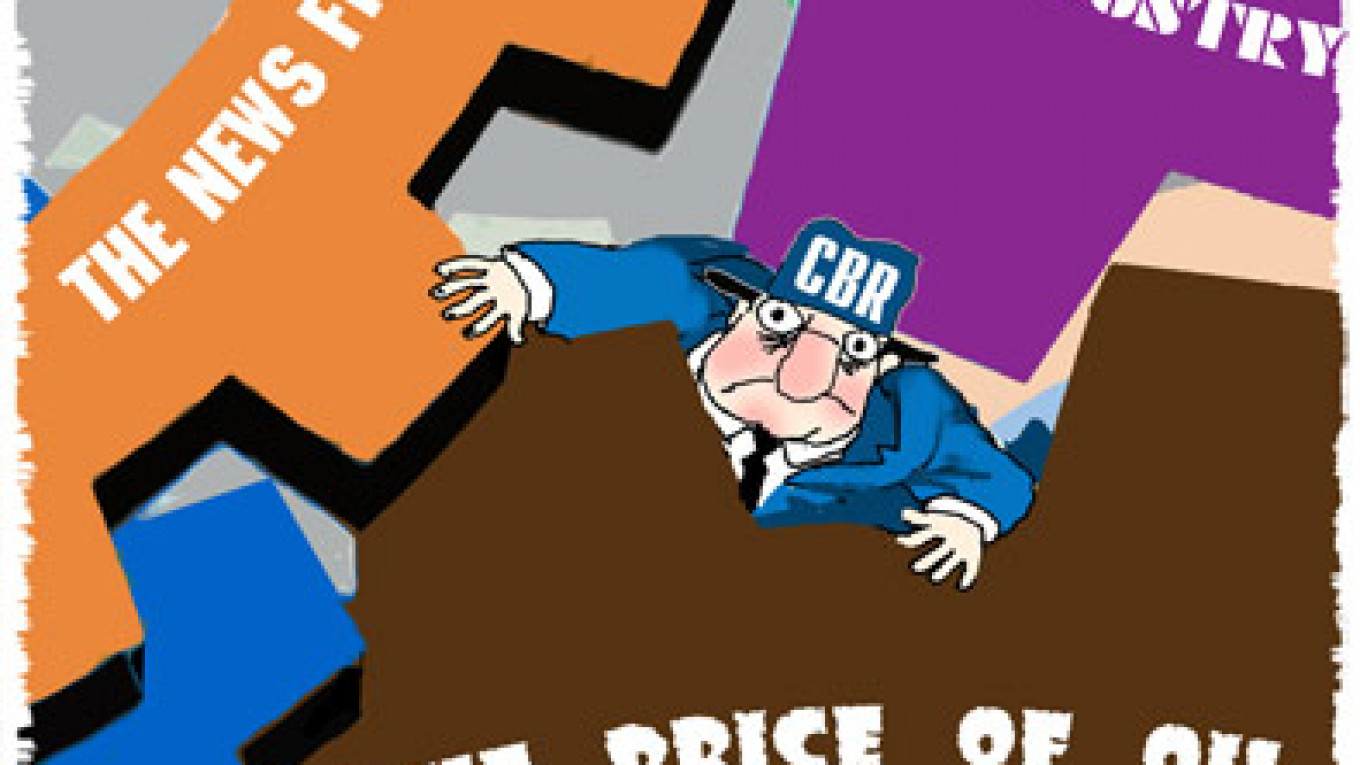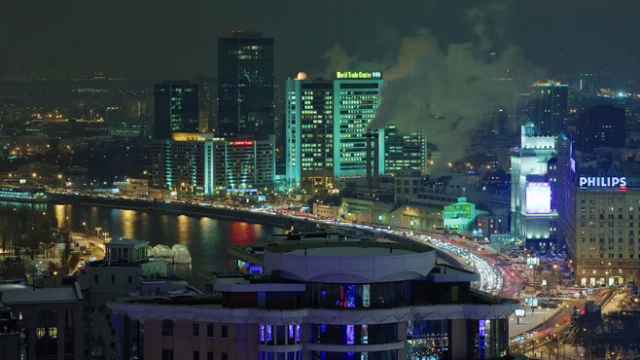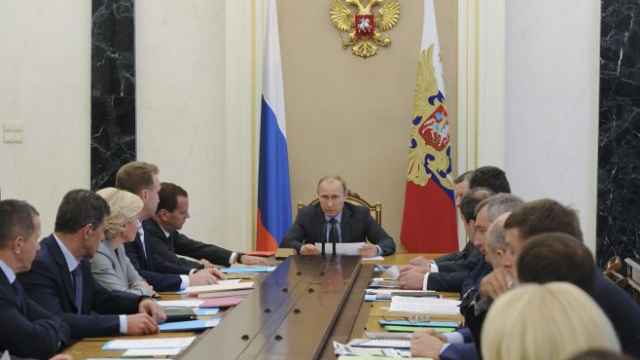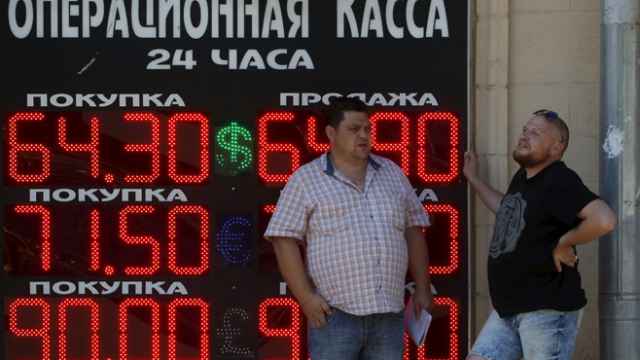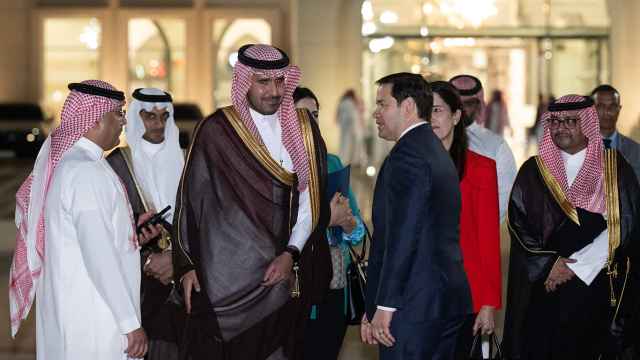It is an easy bet to make that among the topics which persistently preoccupy a majority of people in Russia are inflation and the ruble. That is hardly surprising given the recent memory of last winter's big jump in prices, food prices in particular, and the continued volatility in the ruble exchange rate.
I last wrote about this subject in an August column, and while the gap may seem too small to justify an update, the questions "Where is the ruble headed?" and the even more specific "Should I pay for my New Year's trip now or wait?" do.
Let us combine the monetary troika and ask, "When will the cost of debt servicing fall again?" "When will the rate of inflation fall below 10 percent?" and "What will be the ruble exchange rate in three and six months?" To quote Lenin, "Everything is linked to everything else" and in this case that is absolutely correct. But before addressing these three topics one must first address the most basic question — the oil price. That remains the key determining factor for monetary decisions and trends in Russia.
The price of Brent crude was over $100 per barrel (p/bbl) at the start of August last year, fell to $56 p/bbl at the start of this year and reached a low of $42.7 p/bbl in August before recently rallying to $52.7 p/bbl. The reason for the volatility is mainly traders reacting to various speculations but the underlying cause of the downward trend is that there is simply far too much oil being produced. That excess supply is estimated at between 1.5 and 2 million bbl/d and until either the excess is cut or demand rises to use that supply, the price of oil will remain weak.
Recently the concern over Syria has provided some support for oil, but that will be short lived. Syria is not a major oil producer and has no transit routes across or close to its territory. The price rally is again an opportunistic trader's move.
There has also been some speculation that Russia may finally start to engage with OPEC with a view to cutting supply so as to balance the market. For reasons which are beyond the scope of this article I do not believe that will ever happen. There are far too many sound political, ownership and, probably, technical reasons why it has never happened. All of which suggests that unless there is a cut in production from OPEC producers or from the U.S. shale industry, the price of crude is more likely to remain weak and vulnerable to downward moves.
As we now know, the Russian Central Bank (CBR) has abandoned its efforts to support the ruble and, from earlier this year, has allowed it to free-float with the oil price. As a result the ruble exchange rate against the U.S. dollar has been as high as 49.5 in mid-May and as low as 69.5 in mid-August as the oil price also dipped. The weak ruble is now a mantra linked to the government's import substitution and improved manufacturing competitiveness recovery and growth strategies.
The weak ruble also means that the Finance Ministry converts dollar-based tax revenue at a better rate and can contain the deficit easier. If we assume an average ruble-dollar exchange rate at 65 then the 2015 budget would balance with an average oil price not far off $75. That is down from $113 for 2013 and leaves Russia much better placed to ride out a prolonged period of low oil than most OPEC producers because of their dollar-pegged currencies.
While the current ruble strategy is clear enough, the unanswered questions are "Will the Central Bank remain inactive if the price of oil dips back to $40 p/bbl or lower?" and "Will it intervene to stop the ruble rallying to 50, or better, if the price of oil was to (miraculously) jump to $100?" The former would risk undermining current fragile stability while the latter would destroy the push for competitiveness. For now it seems neither decision is imminent.
This week's rally is entirely about oil and Syria. Given the assumption that the oil price is more vulnerable to the downside between now and year-end, the prudent advice is to convert one's New Year's holiday rubles into foreign currency during this period of strength. Forget about the economic indicators, watch the news from Syria.
The spike in the rate of inflation, to just below 17 percent at the end of March, was directly related to the ruble weakness of late last year and January. Food prices, which were rising by more than 25 percent on an annualized basis at the end of the first quarter, had the added kicker of the sanctions shortages.
Despite the rally in the ruble in the February–May period there was little positive pass-through to inflation. That was because of the rise in utility tariffs and the sanctions effect. At the end of September the annualized rate was at 15.7 percent and that is a big factor why real disposable incomes and household spending are so negative.
But, it is still realistic to assume that the annualized rate of inflation will be close to the Central Bank's target of 12 percent by the end of the year and down to approximately 7 percent before summer next. Weekly inflation has now normalized as tariff increases have been passed through and new sources of sanctioned food have helped moderate prices. The base effect kicks in from January and that will allow for a rapid reduction in the annualized rate in the first quarter.
So what does that mean for interest rates and the cost of servicing debt? Just before the announcement of the referendum in Crimea in early March last year the Central Bank's benchmark interest rate was 5.5 percent. It had already risen to 11.5 percent before the emergency rate hike to 17 percent on Dec. 16. That means that individuals, households and corporations of all sizes, but especially those in the small and medium sized category, have been paying more for debt over the past 18 months. That has squeezed out other spending and contributed to the decline in the economy.
This year the Central Bank has removed the December emergency spike in a series of rate cuts and the benchmark rate is today at 11 percent. But starting to address the 2014 rate increases will have to wait. The Central Bank has made clear that it is not prepared to make any additional cuts until the rate of inflation gets down toward 12 or 11 percent.
That means watching the ruble exchange rate, the oil price and either the fallout from Russia's Syria actions or U.S. shale oil output. Only then will you know whether it is better to pay for that foreign holiday early or to wait. It seems that Lenin was right after all.
Chris Weafer is a senior partner with Macro Advisory, a consultancy advising international companies and investors working in Russia and across the Eurasia region.
A Message from The Moscow Times:
Dear readers,
We are facing unprecedented challenges. Russia's Prosecutor General's Office has designated The Moscow Times as an "undesirable" organization, criminalizing our work and putting our staff at risk of prosecution. This follows our earlier unjust labeling as a "foreign agent."
These actions are direct attempts to silence independent journalism in Russia. The authorities claim our work "discredits the decisions of the Russian leadership." We see things differently: we strive to provide accurate, unbiased reporting on Russia.
We, the journalists of The Moscow Times, refuse to be silenced. But to continue our work, we need your help.
Your support, no matter how small, makes a world of difference. If you can, please support us monthly starting from just $2. It's quick to set up, and every contribution makes a significant impact.
By supporting The Moscow Times, you're defending open, independent journalism in the face of repression. Thank you for standing with us.
Remind me later.



